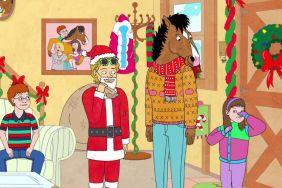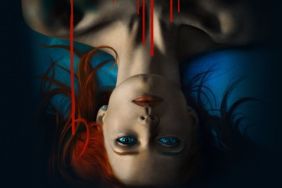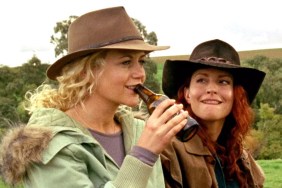The creative team behind the upcoming horror-comedy

January 2008…
If I was Jack Brooks, I’d punch my driver in the head. The bus is crawling through Park City, Utah traffic. I’m late for an interview. It’s not the driver’s fault, really. Sundance madness has swept through this town and commuting hiccups, if you’re relying on public transportation, are bound to happen. Still, if I was Jack Brooks, I’d probably let anger get the better of me. The driver would take a wallop to the skull, I’d rage my way back to the resort, crack a beer and relax in the hot tub teeming with snow bunnies. Screw the interview.
But I’m not Jack Brooks. I’m your devoted writer en route to meet the Canadian production squad behind this year’s choice horror-comedy Jack Brooks: Monster Slayer (opening in limited release from Anchor Bay on August 1st), an indie feature packing ambition, brawn, laughs and an impressive array of practical (hallelujah!) monster FX.
Brooks is a temperamental plumber with some baggage. At a young age, he saw his family killed by a black beast. In turn, he grew up with anger management issues. He forces himself to tap into this fury when his life and classmates are threatened by an evil recently exhumed by Professor Crowley (Robert Englund). The events that unfold position Brooks on a new path in life.
Last night, Brooks director Jon Knautz, producers Patrick White and Trevor Matthews (also leading man), Robert Englund and Ryan Shore faced a jammed Slamdance screening. Bright and early the following morning, I’m on my way to their rented house. When I arrive the fellas are awake. Ready. Coffee does a mean job of using our brain cells like a punching bag to whip us into clarity. I join Knautz, Matthews, White and Shore at the dining room table for a frivolous discussion about the origins of Brooks, the making of their debut feature and discovered internet depravity. Here they are in their own words.
Shock: Evil Dead II is one picture some people were comparing Brooks to last night. But I thought it had more of a Big Trouble in Little China vibe.
Trevor Matthews: I don’t think we go as silly as Big Trouble in Little China, but it is a little over-the-top.
Jon Knautz: Big Trouble did come up. I hadn’t seen it since I was a little kid, I loved it. But I haven’t seen it in a while. You know, there are those movies you loved as a kid, but then you go back and revisit them and it’s like, this fuckin’ sucks… That didn’t happen. I loved Big Trouble even more. Those guys that come out with the crazy hats…?
Matthews: Kurt’s one-liners in the truck, Jesus.
Knautz: And he lifts up that one guy’s hat and starts hammering him in the face…
Matthews: [laced with a Canadian accent] This is Jack Burton on a dark and stormy night…
Shock: What makes Burton and, in your case, Brooks, amiable guys is that they’re blue collar bad-asses.
Matthews: Exactly. Have you seen the Big Trouble in Little China DVD?
Shock: With the music video?
Matthews: Yeah! That’s gotta be one of the most f**kin’ funniest things I’ve ever seen. Oh my God. Remember that?
Knautz: Carpenter’s like, [singing] “Big trouble…”
Matthews: And that guy is at the keyboard, “In little China!”

Shock: It doesn’t help that Carpenter looks like a wizard.
Matthews: It’s sick. Every once in a while you’ll see Carpenter at a Steinbeck machine editing the movie. And his buddies are pointing to him like, “Cut there!”
Shock: So, Jack Brooks came out of a trip to a cottage?
Matthews: Me and Jon found the idea when we were up at my cottage over a few beers. It was a crazy week where we were going to head out there and not come back until we had an idea. We went down and it was a nightmare. A week straight of nothing. Wandering around the woods throwing knives and axes into trees, it was honestly a nightmare. By the end of the first week we’re wearing the same ratty jogging pants and trying to keep our sanity. Then one day, we realized nothing is going to hit us like lightning, let’s just come up with something fun. We started out thinking, let’s make a monster movie. Something Evil Dead, something fun, like Big Trouble in Little China. The concept we came back with, that we pitched to Pat and got the ball rolling, was the idea of a dark and stormy night and burying a crate that has an ancient evil that can transform people…
Patrick White: Well, initially the crate was going to be underwater and then we started rolling with that.
Knautz: Yeah, we were on our boat with Roman Candles. F**k, you take a Roman Candle and you light it and put it on top of the water and it’ll shoot a glowing ball right down to the bottom of the lake. It stays lit for three or four feet under the water and it lights up the ground.
Matthews: And we thought, what if there were these two drunk college dudes who go out in a row boat and one of them is fishing, the other is rolling a joint and they start lighting these Roman Candles. They point it down and it illuminates the water and they find something. They pull this thing out of the water and then it develops from there.
White: That was the first time. The second time you started to develop the story, you went out and came back the next day and had this idea of a four-armed gorilla. Something Jack could fight.
Matthews: And that’s where the idea came from of the movie’s bookends with Jack fighting the cyclops. Jack Brooks is in a hut, he’s got this huge beard – he’s not a student any more – and there are these natives running around, all terrified of this four-armed gorilla. Just when Jack is about fight it, a voice over comes on and says, “Let me tell you about my life…” Then it flashes back to Jack and his parents getting killed and all sorts of shit. Theoretically, we kept that but all of this was a big step forward for us and a turning point in the development.
Shock: How did this madcap union come about? Did you all know each other already?
White: Actually, Jon and I met at the Vancouver Film School back in 2001 and we were talking about a short film, Apartment 310, and we wanted to work together again, so we started to apply for grants and cash. At the time, Jon moved back to Ottawa and I was working in Vancouver and Toronto.
Matthews: Jon and I, when he moved back to Canada, started working on short films together and getting to know each other. Then these guys got their grant for [the short film] The Other Celia, I jumped on board that. We shot that in Toronto.
White: Trevor then wanted to make a company out of things after that. I moved up to Ottawa and lived with him for eight months, then we did Still Life. After that, we wanted to get into a feature.
Shock: Did you know then that you were already going to star in the film, Trevor?
Matthews: I had this idea of forming a company that was going to be a creative atmosphere. We could sit down together, brainstorm concepts we wanted to make. I’d put the financing together and we’d make them. That started out great. Still Life came up in about a month or two. When casting came up for that short, I had the ambition to act. The guys were supportive of that. For Jack Brooks, it wasn’t that easy.
White: It was always thought of you as being the lead, right?
Knautz: I wanted Keanu Reeves, but he was busy doing another project.
Matthews: Yeah, he was busy doing Speed 3 or something.
Knautz: I never wanted you to play the part. [laughs]
Shock: And the dark underbelly of making the film begins to reveal itself. Did the financiers ever present their idea of who’d they would like to see in the film?
White: No, because the financiers was Trevor’s family. And once they believed in the project and trusted us, they were hands-off allowing us to do what we wanted to do.

Shock: A $2.5 million budget is a significant amount of spending cash after working in short films.
Knautz: It was tough for me thinking about how much we had at our disposal. I treated it like a short film just knowing that this was going to go longer. I let Pat do his thing and I just focused on the directing, but subconsciously I knew the money we had was pretty f**kin’ cool.
Matthews: It was daunting. We had never done anything like that before.
Knautz: I had never shot on 35mm before. On the short films it was always like, “Should we do another take? It’ll cost money to run more film through the camera.” Here, it was like doing takes seven or eight, it was really cool.
Shock: You’ve got a helluva lot of rubber on display with the monsters – how was it playing with those guys?
Knautz: It was tough. Just doing them all practically, for sure. I think we were all in over our heads on the big classroom monster because it was so big. It needed professional puppeteers to operate it. You can put everything into making it look good – David Scott did a fantastic job – but it wasn’t just one guy in there, there were four or five people making the thing move. To choreograph and coordinate it, to move the eyes or the head at the right time, it was just really tedious.
Shock: How did you find David Scott for the FX?
White: When set out to do this, we all sat down and watched the DVDs of the Evil Dead films. We wanted to get one of these guys in Toronto who was working for a big FX house and tell them we wanted to find a guy who was dedicated and truly loved this stuff. We put phone calls out and sent the script around. We heard from five different companies and it was clear Dave Scott was the most enthusiastic. He sent us drawings right away, gave us a really competitive rate and you could just tell he loved it.
Matthews: That was a big thing for us. We were the employer so the whole philosophy was, let’s definitely go for quality, the best. But the other thing was: Who do we connect with? Who do we believe in and who is enthusiastic? As soon as Dave Scott came on the project, we all just knew. Scott, the very next day after we initially talked, had drawings of the monsters.
Shock: Getting back to the story, you guys knew from the outset this was a film that wasn’t going to take itself too seriously…
Knautz: The whole horror-comedy thing? Absolutely. I got stoked when we came up with the four-armed gorilla thing that eventually turned into a cyclops, because I thought that was a cool opening.
Matthews: I fought so hard for the four-armed gorilla.
Knautz: Yeah, you really liked that thing. I just thought about what Clive Barker said about hitting the audience with what you got in the first five minutes so they know what they’re in for. I believe in that theory with horror films. But we wanted to be over-the-top so people don’t think, I don’t know, we’re trying to be really cool or something. [laughs]
Shock: Trevor, you play Jack, but you also play one particular monster, too. Any reason for that?
Matthews: I wanted to. I’m a pretty physical guy. Before getting into film, I was going down the path of being a professional snowboarder. I like doing a lot of physical stuff. In playing the troll, I just knew I’d do a good job with it. I’m pretty monkey-like as it is. [laughs] I put everything into that damn troll costume. It was like three hours of makeup and when Dave Scott would get me into the costume, he’d be putting this shit on my face. And I couldn’t get it off after ten showers over the course of three days. Rubbing alcohol all over my face and I’d still have layers of caked-on makeup. It wasn’t always fun, but I wanted that experience.
White: Going back to Evil Dead, Trevor gave us a Bruce Campbell-like flexibility. As a producer, I was like, “Alright, Trevor, you’re going to be that creature from first thing in the morning until the end.” And we didn’t have to worry about unions because Trevor was also a producer so we were able to beat him up as much as we wanted.
Knautz: Physically, he’s all over it, so why go out looking for someone who is going to cost money? It’s just funny to torture your friends on set anyway. You’re getting bored and waiting around, so you’ll throw a stick at his head.
White: Or leave him hanging upside down.
Knautz: I wasn’t purposely torturing him that time, though. I remember you were like, “Dude, I’m going to throw up…”
Matthews: I’m gonna puke. You asked if I was okay and I was on the verge of throwing up everything I had eaten for lunch.

Shock: This was when you were doing wire work as Brooks…
Matthews: Yeah, the upside down stuff. I was good for the first five minutes. But Jon, you didn’t have to do it for 25-minutes.
Knautz: [laughs]
Shock: This might explain the high insurance costs you referred to on the panel last night?
White: Oh, no… What Trevor was talking about was when we were shooting the mutant Celia part, the film went back to the lab. Something broke in the lab and our film just sat there, footage got destroyed. We had to re-shoot it. When that one guy last night asked us how long we shot – we were only going to be eight weeks, but when we had that problem, we had more. We still had young Jack stuff to do, but that problem added four extra days to the shoot.
Shock: Talk about the casting of Robert Englund…
Knautz: We went through a casting agent through the usual channels. When we sat down knowing it was going to be greenlit and everything we wanted a name for Professor Crowley, obviously someone like an icon in the genre. Robert was right up there as our number one choice. I didn’t think we could get him. Robert really liked Still Life, the short film, and he liked the Evil Dead vibe of Brooks. It’s funny, I was watching the special features on the Hatchet DVD and I saw the phone call Adam Green had with Robert. I could relate to that ’cause I remember Robert calling up and saying, “Hey, what’s up? Let’s do this!”
Shock: Ryan, you’ve been awfully quiet so let’s talk about the music – how’d you get mixed up with these guys? And how are you related to Howard Shore?
Ryan Shore: He’s my uncle. I got my start with Howard. I went to the Berkeley College of music – he recommended I go there. After I graduated, I worked with him for four years. I got involved with Jack Brooks through Trevor. How’d that happen?
Matthews: J-date. We just hit it off and he’s like, I do music.
Shore: I think we started with poking each other online.
Matthews: Did I poke you or did you poke me?
Shore: I think we poked each other. [laughs]
Matthews: I remember calling Ryan and having a conversation with him. He was a bit out of our price bracket because he’s such a stingy prick. [laughs] But I liked him, even though he said, “Look, I don’t think I could do this project.” I originally asked him if he could do it for $10k or $15k – at the point you were at in your career, that was below you.
Shore: I’m at that point now after doing this film. [laughs]
Matthews: The reason I called Ryan in the first place is because he did an animation called Rex Steele: Nazi Smasher. There’s a theme song in it that’s just awesome. I loved it. Now I get my secretary at [our production company] Brookstreet Pictures to play it every morning when we show up for work. It’s got this upbeat feel. I must’ve played it for ten days straight before contacting Ryan. But anyways, he and I talked for an hour and half. He gave me the feedback on what the rates are and going with an orchestra as opposed to doing it digitally. Just gave me the whole scoop on the business. We had such a nightmare trying to find other people, we wound up going back to Ryan and negotiating a rate. Now we all love each other.
Shore: When I first saw the movie, all of the temp stuff they put in was great orchestral music. And it had such a great impact on the movie.
Knautz: Yeah, it was a lot better, eh? [laughs]
Shore: And in the original discussion, it was all about doing it with synth. It just didn’t feel like it would be possible to achieve what was happening there. I’m really grateful the way it worked out the way it did.

Knautz: I think the subject matter and the character, it’s epic and heroic, even though it’s not an epic movie. It afforded us the opportunity to go out and do some big epic type score. Because it’s not taking itself all that seriously we got away with it.
Shore: That was one of the things that really attracted me to the project, besides the people. It just seemed like it would be so much fun. Different styles to go with.
Shock: Now you guys are trying to figure out what’s next?
White: Trying to figure out what’s next.
Matthews: We are going to do a biopic about TwoGirlsOneCup.com.
Shock: Thank you. Because I always thought there was a definite story behind that video.
Matthews: [laughs] How they got there, what they do…
Shock: Tons of potential there. Have you seen the guy who chops his scrotum off with a hatchet on a cutting board?
Matthews: Oh my god, no! But we watched some video of a guy getting nailed by a horse last night.
Knautz: Seeing something this big going into someone this small… [laughs]
[About this point we begin to discuss similar, nightmarish cases of bestiality that found their way into the mainstream press.]
Shock: Wow, the conversation really kicked up a notch there.
Matthews: [laughs] Yeah, to get us back on track. We’ve got a good team and we’re looking for more projects to develop. If Ryan’s going to come on board and do the score, he can definitely make up for our filmmaking abilities. Between Pat and I producing and Jon directing, we’ve got a good team looking for a few scripts. Books we’re looking at optioning.
Shock: There’s an ’80s horror remake you’re eyeing…
White: We can’t say anything yet.
Matthews: If we had the rights, we’d tell you right now. It’d make a killer remake.
Shock: Is it a Canadian horror film?
White: It is, but it’s not really well known. Right now we’re just waiting for the release of the Oscar nominees to see if we’re in contention even though Jack Brooks hasn’t even been released.
Matthews: We’ve always wanted to be like chameleons at Brookstreet where we do a variety of projects. Do something like Jack Brooks, then something like Fargo. We’re going to mix it up.
For more on Jack Brooks: Monster Slayer – including a trailer, poster and stills – click here.





Source: Ryan Rotten









